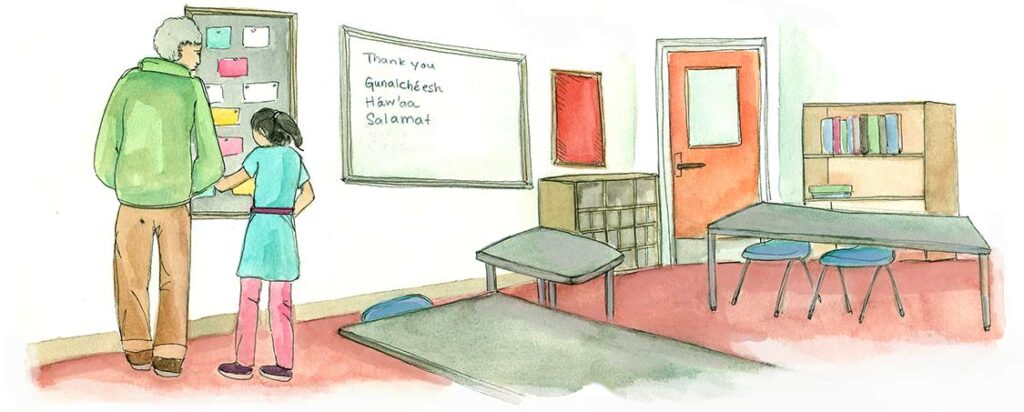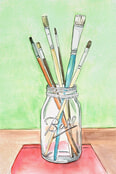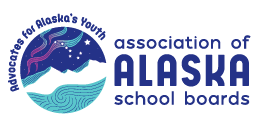Relationship Building

See connections in all things because all things are related.
Alaska Native Values
What is this section about?

Relationship building is at the foundation of any trauma-engaged approach. Strategies that strengthen supportive relationships help students, staff, and communities make positive, caring connections between each other and within the school environment. Students who feel safe, secure, and connected achieve greater success. Transformative schools help foster relationships at all levels between adults and students, among students, and among adults in schools, within families, and within communities. This section includes information on building capacity in school districts to foster supportive relationships between all members of the school community (staff, students, and families).
Community Adaptations
The content of this chapter is offered to district leaders, school staff, afterschool providers, and community members with the intention of supporting a whole school, whole community approach. The toolkit is offered with the understanding it may need to be adapted to make the practices culturally relevant and to align to each community’s strengths, norms, and expectations.
Trauma Engaged Schools Knowing to Doing Video Library
The Trauma Engaged Video Library offers over 50 peer-led and statewide experts short videos tied to the topics in the Framework. They are under 10 minutes and easily accessible for personal review or in a group setting to stimulate discussion. Below is the video series for this chapter.
Click on the banner on the top left of the video screen to see the chapter video titles.
What Can Leadership Do?
Click each section below for more info.
A. Build your own social-emotional skills to establish trusting relationships with students, colleagues, and families (through professional development, reflective practice, etc).
- How to Build Great Working Relationships
This article gives brief overviews of topics including emotional intelligence and development of positive mindsets. Full access requires subscription.
- How to Win Friends and Influence People
A short video based on a book that has survived the test of time, this video addresses ways to build trust and relationships. Based on the teachings of Dale Carnegie and his bestselling book, “How to Win Friends and Influence People.”
- Strategies for Teachers to Develop Positive Relationships with Students
This site includes ideas for connecting teachers with students and includes video that could be used for professional development.
- Leading with Trust – Five Steps to Repair Broken Trust
This site shares five simple steps for leaders to help increase feelings of trust, transparency, and accountability.
B. Review and analyze district and school data with staff to better understand student and staff perceptions about relationships at school. ex: Climate and Connectedness Survey, Youth Risk Behavior Survey. Ensure the data is uncomplicated, understandable and accessible to all staff.
- Alaska School Climate and Connectedness Survey
A survey completed by students in grades 3-12, school staff, and community members. Most Alaska schools participate in this annual survey.
- Alaska Youth Risk Behavior Survey
A statewide survey administered by the Alaska Department of Health and Social Services.
- Student and Staff Supportive Wellbeing Questionnaire (SSWQ)
Rating scale for measuring student and staff school-specific well-being. Includes related research articles. Source: Sitka School District with permission from Diana Browning Wright.
C. Use data to identify specific goals for establishing, maintaining, restoring, and strengthening relationships that support a positive school climate.
- Educating the Whole Child: Improving School Climate to Support Student Success
This article is a comprehensive document for district leadership outlining necessary shifts in supporting the whole child. By Linda Darling-Hammond and Channa M. Cook-Harvey.
- The Center for Courage and Renewal
A resource on building adult communities in schools and cultivating trust. This program helps principals and staff members create a safe space to do the necessary inner work for building trust and community.
- Learning Style Tests for Children
An article with information about multiple highly used inventory tests. Includes an inventory for parents and teachers.
- Resources for Learning Style Tests
Shares a number of learning style inventories appropriate for ages preschool through adult – it is also included in the professional learning portion of this chapter’s toolkit.
D. Create and maintain a positive, professional climate that supports staff values, interactions, and collaborations by establishing working agreements that are clear and concise.
- The Power of Team Norms
A short article from Educational Leadership supporting the importance of developing group norms.
- Working Agreements Defined
Three methods for developing working agreements to support effective interactions between group members.
Protocols for developing group norms:
- Forming Ground Rules (Creating Norms) | School Reform Initiative
- Setting Agreements Activity | National School Reform Faculty
- 10 Steps for Establishing Team Norms | Center for Creative Leadership
- Developing Schoolwide Norms | CASEL – An activity for developing school-wide norms (available with registration for an account).
E. Provide time for reflective practice and professional learning opportunities that help build individual capacity for strengthening supportive relationships among students, staff, and families.
- Every Opportunity
This high-impact video demonstrates the importance and power of building relationships and how all staff impact school climate.
- The Power of Relationships in the School
This video underlines the importance of creating an environment where students feel safe and supported by adults at school.
- Establish, Maintain, Restore Activities
Relationships are at the heart of what youth need to learn, grow, and thrive. This collection of resources includes research, a PowerPoint presentation, and activities for staff to explore ways to establish, maintain and restore relationships with students.
Source: Sitka School District with permission from Diana Browning Wright.
What Can Staff Do?
Click each section below for more info.
A. Build personal social-emotional skills to create positive relationships with students, colleagues, and families that includes the understanding and use of healthy boundaries.
- Building Great Work Relationships
A short article from MindTools on developing strong relationship skills. This resource includes a paragraph on working with “difficult people.”
- 8 Tips for Developing Positive Relationships
This site shares eight universal tips for developing positive relationships that will benefit professionals in any workplace.
- Relationships: The Tool That Was Never Taught
This TEDx video by Dominique Smith offers tips on building relationships.
- Alaska Native Knowledge Network
Sharing understandings and resources from Alaska communities, the Alaska Native Knowledge Network has a variety of resources for free and for purchase.
B. Use proactive communication skills that help to cultivate relationships and support a positive school climate. This includes active listening and ensuring every voice is heard.
- Search Institute: How Can You Grow Developmental Relationships with Young People? How to get relationships right.
Includes a video, discussion guide, and additional resources.
- 10 ways to have a better conversation
This TED Talk by Celeste Headlee has over eight million views and discusses how to effectively talk and listen.
- Active Listening: How To Communicate Effectively
A five-minute video for high school students.
- 10 Tips to Change From Reactive to Proactive in Situations
Ten tips from Psychology Today on how to be less reactive in difficult situations.
- “Culturally Responsive Teaching and the Brain”
A book and blog by Zaretta Hammond that offers answers to our collective and individual questions about how to help students become confident and competent learners.
C. Maintain relationships by using consistent practices to sustain connections over time. Create opportunities to check in with students, colleagues, and families.
- How Teachers Build Great Relationships with Students
Practical strategies to help teachers develop positive relationships with students.
- Student-Student Classroom Interaction
A website that shares tips for improving student interaction, explores how student-to-student interaction impacts learning, and looks at ways to structure classrooms to support positive student-to-student interaction.
- My Top 5 Strategies for Student-to-Student Interaction
Strategies for middle school and high school classroom teachers to support healthy student interactions.
D. Restore damaged relationships through learning about and actively utilizing restorative techniques.
- How to Succeed with People
A short video by Paul McGee with powerful questions that give insight into how to mend relationships when there is conflict.
- Leading with Trust – Five Steps to Repair Broken Trust
Shares five simple steps for leaders to help increase feelings of trust, transparency, and accountability.
E. Reflect on how personal experience and bias impacts relationships and student success.
- Yale Poorvu Center for Teaching and Learning
Implicit bias refers to unconscious attitudes, reactions, and stereotypes that affect behavior and understanding. Instructors can consider a variety of strategies and benefits for revealing and addressing implicit bias, both in themselves and their students.
- Implicit Association Test (IAT)
Online self-assessment to identify biases through Project Implicit from Harvard University
- Four Ways Teachers Can Reduce Implicit Bias
Knowing that all people are subject to bias, this site offers tips to help teachers treat all students with dignity and care.
- Five Keys to Challenging Implicit Bias
Challenge implicit biases by identifying your own, teaching colleagues about them, observing gap-closing teachers, stopping “tone policing,” and tuning into such biases at your school.
- Understanding Implicit Bias – What Educators Should Know
From the American Federation of Teachers
- Common Beliefs Survey: Teaching Racially and Ethnically Diverse Students
Teachers rate their level of agreement with 13 common beliefs about racially and ethnically diverse students, reflect on their beliefs and their possible consequences, and then outline action steps for better serving their students.
- Dimensions of Difference and Similarity Reflection
Teachers reflect on and discuss various dimensions of their identities to gain awareness of the impact of these on their relationships with students and their families.
Additional Resources
Click each section below for more info.
Adult to Student
- 10 Ways to Build Relationships With Students This Year
Resources for supporting adults in building positive relationships with students grades K-8
- Strategies for Teachers to Develop Positive Relationships With Students
A site with ideas and video resources for connecting with students
Student to Student
- Student-Student Classroom Interaction
A website that shares tips and examples for improving student interaction. It also explores student-to-student interaction and how it affects learning, as well as ways to structure classrooms to support positive student interaction.
- My Top 5 Strategies for Student-to-Student Interaction
Strategies for middle and high school classrooms that support healthy student interactions.
Adult to Adult
- How to Build Great Working Relationships
A site with brief overviews that include topics around emotional intelligence and developing positive mindsets. Full access requires subscription.
- How to Succeed with People
A short video by Paul McGee with powerful questions that give insight into how to mend relationships when there is conflict.
Family to School
- Fostering School, Family and Community Involvement
Provides schools with the foundation needed to create and maintain safe schools. Includes basics for school-family-community relationships, collaborations in practice, and policy use for effective change.
- Back-to-School Culture Toolkit for K-12 Leaders
Back-to-school resource and framework designed to build school culture by including all stakeholders.
- Building Relationships in School
With information that speaks to the connection between relationships and the success of a school, this article gives an overview of topics related to building relationships with all stakeholders including families and schools. From the Institute of Arts Integration and STEAM.
Milestone Guide
The Transforming Schools Guide offers some steps and a starting point to deepen personal growth, establish a common vision with colleagues and community, and remind each of us that this is a process of preparing, starting, applying, and refining our trauma engaged work. Individuals and teams move through the steps and cycle many times to continue to improve upon and deepen our trauma engaged approach. Seeing the path forward and celebrating successes are key components of effective implementation. These Milestone guides offer four levels of section to complete, broken out by role. Each of the 11 components within the framework and toolkit.
More Resources
- 10 Ways to Build Relationships With Students This Year
Resources from Scholastic to support adults in building positive relationships with students in grades K-8.
- Back-to-School Culture Toolkit for K-12 Leaders
Back-to-school resource and framework designed to build school culture by including all stakeholders.
- Bright, M. (2017) Why stable relationships are ‘poison control’ in fighting trauma and stress in kids, The Conversation
- Johnson, B. (2008) Teacher–student relationships which promote resilience at school: a micro-level analysis of students’ views, British Journal of Guidance & Counseling, 36(4): 385-398
- Smith, J.A. (2018) How to Reduce the Impact of Childhood Trauma, Greater Good Magazine (Deconstructing Trauma)
- 52 Wolpow, R., Johnson, M.M., Hertel, R., & Kincaid, S.O. (2011). The Heart of Learning and Teaching: Compassion, Resiliency, and Academic Success. Olympia, WA: Office of Superintendent of Public Instruction.
- “Paper Tigers” video
The principal of Lincoln High School changes his school’s approach to discipline to help students overcome traumatic events.
- “Connected and Respected”
This elementary curriculum is based on the nationally recognized Resolving Conflict Creatively program on conflict resolution and social and emotional learning.
- Positive Behavioral Interventions and Supports (PBIS)
The broad purpose of PBIS is to improve the effectiveness, efficiency, and equity of schools and other educational institutions. PBIS seeks to improve social, emotional, and academic outcomes for all students, including students with disabilities and students from underrepresented groups.
